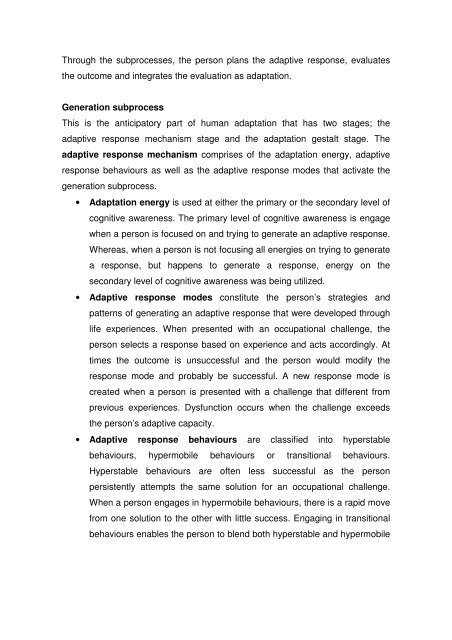Theory of Occupational Adaptation.pdf - Vula
Theory of Occupational Adaptation.pdf - Vula
Theory of Occupational Adaptation.pdf - Vula
Create successful ePaper yourself
Turn your PDF publications into a flip-book with our unique Google optimized e-Paper software.
Through the subprocesses, the person plans the adaptive response, evaluatesthe outcome and integrates the evaluation as adaptation.Generation subprocessThis is the anticipatory part <strong>of</strong> human adaptation that has two stages; theadaptive response mechanism stage and the adaptation gestalt stage. Theadaptive response mechanism comprises <strong>of</strong> the adaptation energy, adaptiveresponse behaviours as well as the adaptive response modes that activate thegeneration subprocess.• <strong>Adaptation</strong> energy is used at either the primary or the secondary level <strong>of</strong>cognitive awareness. The primary level <strong>of</strong> cognitive awareness is engagewhen a person is focused on and trying to generate an adaptive response.Whereas, when a person is not focusing all energies on trying to generatea response, but happens to generate a response, energy on thesecondary level <strong>of</strong> cognitive awareness was being utilized.• Adaptive response modes constitute the person’s strategies andpatterns <strong>of</strong> generating an adaptive response that were developed throughlife experiences. When presented with an occupational challenge, theperson selects a response based on experience and acts accordingly. Attimes the outcome is unsuccessful and the person would modify theresponse mode and probably be successful. A new response mode iscreated when a person is presented with a challenge that different fromprevious experiences. Dysfunction occurs when the challenge exceedsthe person’s adaptive capacity.• Adaptive response behaviours are classified into hyperstablebehaviours, hypermobile behaviours or transitional behaviours.Hyperstable behaviours are <strong>of</strong>ten less successful as the personpersistently attempts the same solution for an occupational challenge.When a person engages in hypermobile behaviours, there is a rapid movefrom one solution to the other with little success. Engaging in transitionalbehaviours enables the person to blend both hyperstable and hypermobile
















